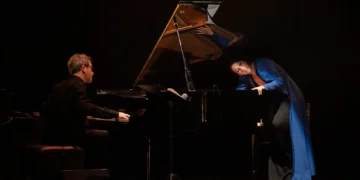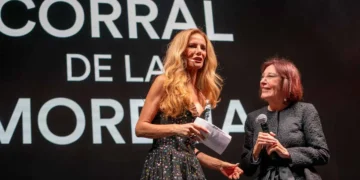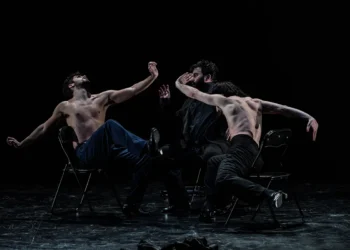|
14th Festival de Jerez 2010
|
|
THIS TIME YOU GOT IT RIGHT, ANDRÉS… Text: Estela Zatania The day began at the Festival de Jerez with another encounter with a veteran artist, this time in the person of dancer Victoria Eugenia, “Betty” as she has long been known, a true personality of Spanish dance. At seven in the evening, David Lagos gave a cante recital in the acoustic venue of the Palacio Villavicenio, accompanied on guitar by his well-known brother, Alfredos Lagos, with the palmas of Carlos Grilo and Luis Cantarote. David took advantage of the occasion to present a series of themes from his record “El Espejo en Que Me Miro”, and perhaps for this reason he employed a strange half-voice not typical of him. With the sure-footedness that comes from years of singing for dance, he offered a wide variety of cante, including cantiñas dedicated to Chano Lobato where the hushed voice was somewhat more appropriate. “LA PASIÓN SEGÚN SE MIRE”. Dance: Andrés Marín. Guest artists: Lole Montoya, José el de la Tomasa, Concha Vargas. Cante: José Valencia, Pepe de Pura. Guitar: Salvador Gutiérrez, David Marín. Arabic oud: Yorgos Karalis. Marimba and percussion: Daniel Medina. Flamenco percussion: Antonio Coronel. Clarinet: Javier Delgado. Tuba: José Miguel Sanz. Coreography: Andrés Marín. Artistic director: Andrés Marín, Pilar Albarracín. Andrés Marín is the kind of artist who risks everything. Not in order to make the big time or hit the headlines, but because his particular way of being, his genius and his spiritual needs do not allow him to travel any other route. In my opinion he has more integrity than any flamenco dancer of our time. Occasionally in his work, artistic concerns seem to be second to conceptual ones, but when he strikes the balance between heart and head, the results are impressive. Last night at the Villamarta Theater, this fortunate singularity took place, and the muses were smiling as they looked on from the wings at the world premiere of “La Pasión Según se Mire”. Marín’s dancing is impeccable. Like it or not, and there are those who don’t, what you see on stage in Marín’s work, is exactly what he wanted you to see, there’s no slip twixt the concept and the execution. It’s a daring undertaking that reveals the sacrifice that went into it, not only in rehearsals, but the attention to lighting and atrezzo, the selection of cantes, musical details and staging. When the curtain goes up, Lole Montoya, she of “Lole and Manuel”, stands bathed in an overheard red light singing in Arabic, while Andrés Marín twists and churns on the floor like a recently arrived alien. Little flash-lights, a xylophone that plays strange, almost comic notes, futurism and a feeling of science-fiction. We have just begun a journey to the center of the fertile mind of Andrés Marín. Singer Pepe de Pura sings tientos to free-form compás and without music, then liviana, serrana y siguiriya with the Manuel Molina closing like you’ve never heard it before, with novel harmony, and Marín is a hieroglyph in motion. And it’s all a perfect little flamenco suite. The next jewel: a tuba-player with tuba (yes, a tuba) enters slowly, followed by dancer Concha Vargas, and shortly afterwards, Marín. The most unlikely couple one could imagine: the controlled intensity of the slim man, the instinctive movement of the voluminous woman, and they dance together, and it not only works, it’s spectacular. The most eloquent tacit lesson as it lays out the past, present and future of flamenco dance, meeting seamlessly at one common timeless point. No fusion or purity or fads here. Just flamenco laid bare. José Valencia conjures up the cantiñas of Lebrija for Marín’s dance. The tuba man returns, insinuating a Diego del Gastor falseta, and the surprising dance couple of Marín and Vargas move to the compás of a romance. The absence of expression in Marín’s face is fascinating: no feigned suffering, no public relations smiles. Lole, high-priestess dressed in white, an illuminated backdrop with projected abstract images and Marín as a barely-seen spirit. José de la Tomasa arrives on scene singing soleá with the incidental notes of a clarinet; always an odd touch to force us to rediscover classic forms via new ones. The most ingenious scene, because more than dances or numbers, these are scenes, is the Holy Week one. When Andrés Marín appears, bare-chested, wearing white stretch pants with suspenders and a tall conical hat, you don’t know whether it’s supposed to be a member of the KKK, or a child being punished, or….of course!, when the clarinet, drums, tuba and guitar arrive, not to mention two carts with 80 lit candles (I counted them), the audience chuckles at Marín’s little joke, and we know he’s a half-dressed penitent from a Semana Santa procession. The message is clear and straightforward: the avant-garde is not incompatible with classic flamenco, there’s still plenty of room for creativity and flamenco is bigger than any passing fad. DE SANDALIA A TACÓN. Dance: Ana Morales, Rubén Olmo. Cante: Moi de Morón, Antonio Campos (guest artist). Guitar: Jesús Guerrero, Óscar Lagos. Percussion: Israel Katumba. Voice and violin: Jallal Chekkara. Choreography: Ana Morales.Coreography of Telethusa, Fandango: Rubén Olmo. At mignight in the Sala Compañía, Ana Morales, winner of last year’s dance prize at La Unión, tried to cover the entire history of Spanish and flamenco dance from the dawn of time in just over an hour of strange, fanciful choreographies that mostly served to demonstrate how little they had in common with flamenco dance, and which left the audience bewildered much of the time. However, Ana’s classic alegrías with bata de cola was noteworthy, as was the work of singers Antonio Campos and Moi de Morón. |

























